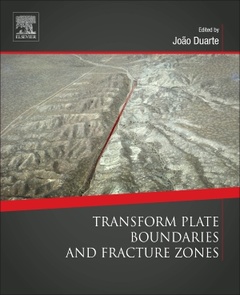Description
Transform Plate Boundaries and Fracture Zones
Coordinator: Duarte Joao C.
Language: English
Subject for Transform Plate Boundaries and Fracture Zones:
478 p. · 19x23.3 cm · Paperback
Description
/li>Contents
/li>Readership
/li>Biography
/li>Comment
/li>
Transform Plate Boundaries and Fracture Zones bridges the gap between the classic plate tectonic theory and new emerging ideas, offering an assessment of the state-of-the-art, pending questions, and future directions in the study of transform plate boundaries and fracture zones. The book includes a number of case studies and reviews on both oceanic and continental tectonic settings.
Transform Plate Boundaries and Fracture Zones is a timely reference for a variety of researchers, including geophysicists, seismologists, structural geologists and tectonicists, as well as specialists in exploration geophysics and natural hazards. This book can also be used as an up-to-date reference at universities in both undergraduate and postgraduate levels.
1. Franz Lotze and the origin of the idea of Transform Faulting in Central Europe 2. Global characteristics of oceanic transform fault structure and seismicity 3. Topographic and morphologic evidences of deformation at oceanic transform faults: far field and local field stresses 4. Reactivation of Oceanic Fracture Zones in Large Intraplate Earthquakes? 5. Mineralization at oceanic transform faults and fracture zones 6. Seismic Behavior on Oceanic Transform Faults at the East Pacific Rise 7. Structural reorganization of the India-Arabia plate boundary (Owen Fracture Zone, NW Indian Ocean) 2.4 million years ago 8. Tsunamigenic Potential of the Gloria Strike-Slip Fault in the NE Atlantic: A Review 9. Continental transform faults: congruence and incongruence with normal plate kinematics 10. The San Andreas Fault System: Complexities along a Major Transform Fault System and Relation to Earthquake Hazards 11. Spatial and temporal distributions of deformation in strike-slip faults: The Karakoram Fault in the India-Asia collision zone 12. Stretching Transforms – Mediterranean examples from the Betic-Alborán, Tyrrhenian-Calabrian and Aegean-Anatolia regions 13. Strike-slip faulting in the Calabrian accretionary wedge: using analog modeling to test the kinematic boundary conditions of geodynamic models 14. Plio-Quaternary extension and strike-slip tectonics in the Aegean 15. Strike-slip fault systems along the northern Caribbean plate boundary 16. Morphotectonics of the Sea of Marmara: basins and highs on the North Anatolian continental transform plate boundary17. Tectonic segmentation of the Dead Sea Fault system: a review of geophysical evidence 18. On seismicity and structural style of oceanic transform faults: a field geological perspective from the Troodos ophiolite, Cyprus
Geophysicists, seismologists, geologists, earth scientists working in related fields such as geodynamics, structural geology, exploration geophysics, natural hazards, etc.
- Reviews ideas and concepts about transform plate boundaries and fracture zones
- Includes a variety of case studies on both oceanic and continental settings
- Addresses innovative and provocative ideas about the activity of fracture zones and transform faults and their impacts to the human society
These books may interest you

Plate Boundaries and Natural Hazards 199.01 €



